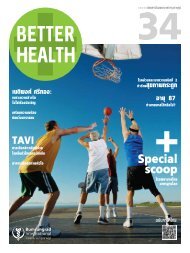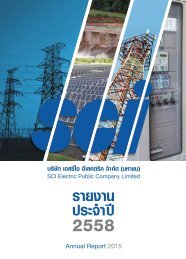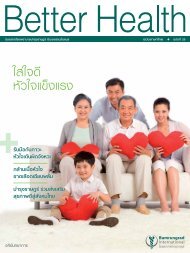Better Health 34 ENG
The magazine for patients and friends of Bumrungrad International Hospital, Thailand.
The magazine for patients and friends of Bumrungrad International Hospital, Thailand.
Create successful ePaper yourself
Turn your PDF publications into a flip-book with our unique Google optimized e-Paper software.
+ Surgical aortic valve replacement<br />
is the standard treatment, which<br />
entails open-heart surgery to remove<br />
the old valve and surgically implant<br />
a new one.<br />
+ But in Transcatheter Aortic Valve<br />
Implantation (TAVI), the physician<br />
inserts a prosthetic heart valve<br />
through the femoral artery in the<br />
groin or through a small cut on the<br />
left side of the chest to get to the apex<br />
(tip) of the heart. When the catheter<br />
gets in the correct position at the<br />
aortic valve, the surgeon releases the<br />
new folded-up valve in the delivery<br />
system to roll out and replace the<br />
degenerated valve.<br />
Surgery is not the solution for all<br />
Although surgery is a highly effective<br />
standard treatment for aortic valvular<br />
stenosis, not all patients are able to<br />
receive it. This major surgery requires<br />
general anesthesia, use of a heart-lung<br />
machine, and may take up to three to four<br />
hours. Some patients may not be able<br />
to withstand such an intense surgery,<br />
especially the elderly, or those who have<br />
previously had open chest operations,<br />
and those with several underlying<br />
diseases. The surgical mortality rate is<br />
substantially high for these patients.<br />
“If the medical team considers open<br />
heart surgery too risky, we recommend<br />
TAVI to reduce complications. This<br />
6<br />
method takes about an hour, and the<br />
patient receives a small cut from<br />
the incision, enabling quick hospital<br />
recovery of only five to seven days. The<br />
standard surgical method may require<br />
two to three months of recovery,”<br />
says Dr. Wattanaphol.<br />
Suitable candidates for TAVI<br />
+ Patients with severe aortic stenosis<br />
+ Elderly patients, especially those<br />
over 80 years of age<br />
+ Patients with underlying conditions<br />
such as lung disease, aortic atherosclerosis,<br />
or who have previously<br />
received cardiac surgery<br />
Preparing the patient for TAVI<br />
TAVI requires preparation, expertise,<br />
and collaboration among medical<br />
professionals such as cardiologists,<br />
cardiac surgeons, anesthesiologists,<br />
ultrasound physicians, skilled nurses,<br />
and physical therapists. The TAVI team<br />
at Bumrungrad has been internationally<br />
trained and can explain the treatment<br />
options and procedures to patients<br />
and their relatives.<br />
Above all, Bumrungrad International<br />
Hospital values the quality and<br />
standards of patient care. Our medical<br />
team provides patients with thorough<br />
and rigorous care, including diagnosis,<br />
meeting with families before and after<br />
the treatment, and close follow-ups, to<br />
ensure that our patients receive the<br />
best care in regaining health.<br />
+ Patients with high surgical risk,<br />
as determined by the attending<br />
physician who assesses appropriateness<br />
using standard riskfactor<br />
analysis<br />
+ Patients estimated to live longer<br />
than one year, and who do not have<br />
advanced cancer
















